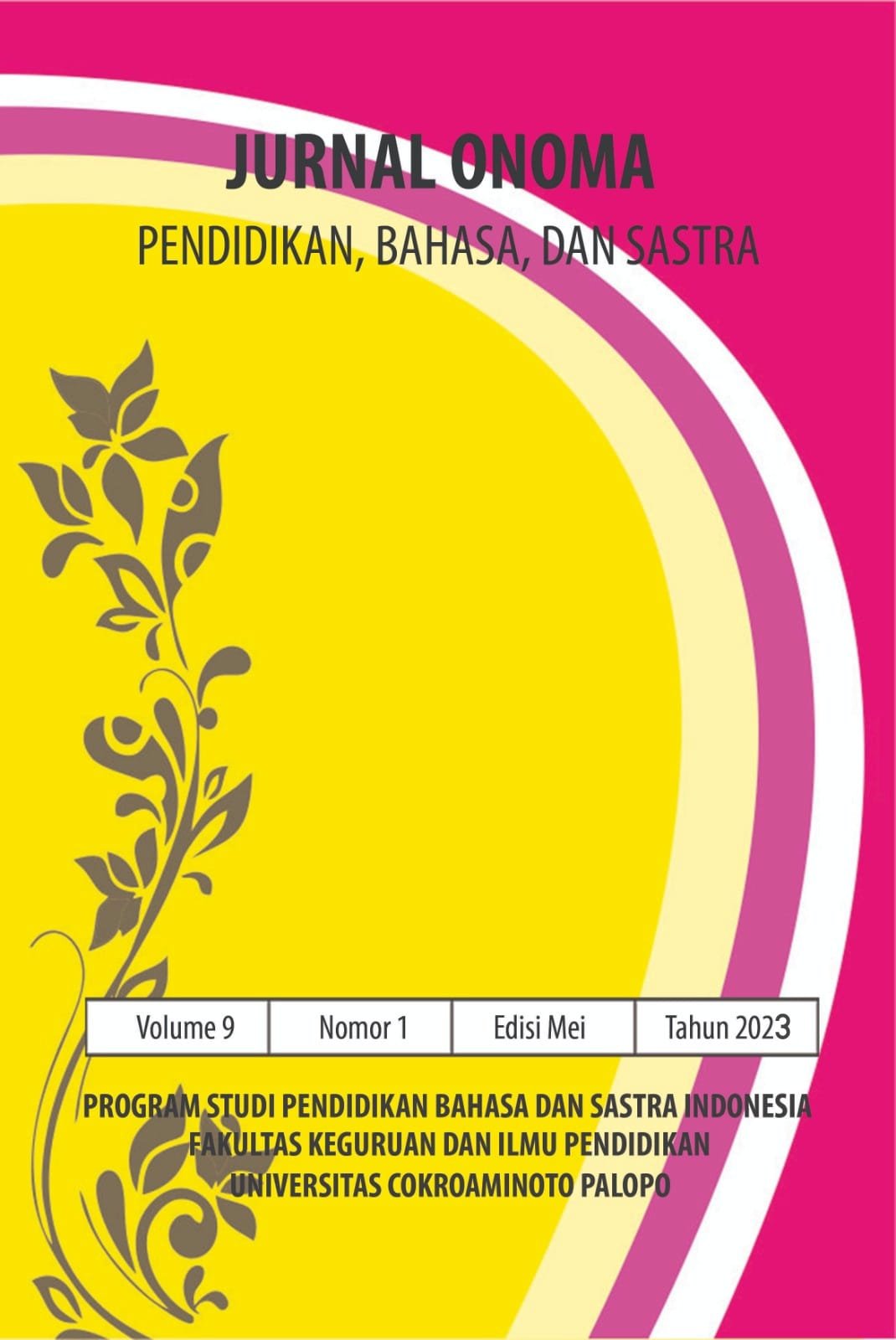Analisis Kesalahan Penempatan Kata Bantu Struktur 的de Pada Kalimat Berfrasa Endosentrik Atributif Dalam Bahasa Mandarin
https://doi.org/10.30605/onoma.v9i1.2246
Keywords:
Bahasa Mandarin, Kata Bantu Struktur 的de, Frase Endosentris AtributifAbstract
Kesulitan dan kesalahan yang sering ditemui pemelajar saat mempelajari Bahasa Mandarin, salah satunya adalah dalam penempatan dan penggunaan kata bantu struktur 的 de pada kalimat berfrasa endosentris atributif. Bahan literasi yang tidak memadai, menyebabkan kesulitan pemelajar dalam memahami hal ini. Dalam penelitian ini, peneliti menganalisis kesalahan penempatan kata bantu struktur 的 de pada kalimat berfrasa endosentris atributif dalam Bahasa Mandarin, serta dengan teoritis dan spesifik menjabarkan kata bantu struktur 的 de tersebut apakah bersifat wajib pakai, jangan pakai ataupun bebas pakai pada kalimat berfrasa endosentris atributif dalam Bahasa Mandarin. Tujuan penelitian ini adalah agar pemelajar maupun pengajar Bahasa Mandarin bisa lebih memahami aturan penempatan dan penggunaan kata bantu struktur 的 de pada kalimat berfrasa endosentris atributif dalam Bahasa Mandarin.
Downloads
References
Alwasilah, A. Chaedar. 1993. Pengantar Sosiologi Bahasa. Bandung: Angkasa.
Corder, S. P. 2017. Introducing Applied Linguistics. New York: Pelican Books.
Fang, Y.Q. 2008. Shiyong Hanyu Yufa 实用汉语语法. Beijing: Beijing Yuyan Daxue Chubanshe.
. 2008. Shiyong Hanyu Yufa Xiti Ji Jieda 实用汉语语法习题及解答. Beijing: Beijing Yuyan Daxue Chubanshe.
Kridalaksana, H. 1984. Kamus Linguistik. Edisi Ke-2 Cetakan Pertama. Jakarta: PT. Gramedia.
Liana, S. 2018. Kesalahan Penggunaan Kata Bantu Struktural “的de” Mahasiswa STBA-PIA Medan. Skripsi. Sekolah Tinggi Bahasa Asing Persahabatan Internasional Asia (STBA-PIA). Medan.
Pateda, M. 1989. Analisis Kesalahan Bahasa. Flores: Nusa Indah. Pranowo. 2014. Teori Belajar Bahasa. Yogyakarta: Pustaka Belajar.
Prastowo, A. 2008. Menguasai Teknik-teknik Data Penelitian Kualitatif. Yogyakarta: Diva Press.
Ramlan, M. 2017. Ilmu Bahasa Indonesia Sintaksis. Yogyakarta: CV. Karyono.
Roekhan, N. 2017. Dimensi-Dimensi dalam Belajar Bahasa Kedua Bandung: Sinar Baru Algensindo.
Satriani, N. A.2017. Analisis Kesalahan Penggunaan Kata Bantu Aspek了 着 过 pada mahasiswa semester IV program studi pendidikan bahasa Mandarin, Skripsi: Universitas Negeri Semarang. Semarang.
Sun, D.J. 2003. Hanyu Yufa Jiaocheng 汉语语法教程. Beijing: Beijing Yuyan Daxue Chubanshe.
Tang, J.X. 2008. Xiandai Hanyu 现代汉语. Shijiazhuang: Hebei Renmin Chubanshe.
Tarigan, H. G. (1987). Pengajaran Wacana. Bandung: Angkasa.
Wikarta, A. R. 2017. Kesalahan Struktur Frasa Subornatif Bahasa Mandarin, Jurnal Lingua Cultura Vol.9 No. 1 pp 21-27. DOI: https://doi.org/10.21512/lc.v9i1.757
Yang, Y.L. & Wu, Z.W. 2013. Guoji Hanyu Yufa Yu Yufa Jiaoxue 国 际汉语语法与语法教学. Beijing: Gaodeng Jiaoyu Chubanshe.
Downloads
Published
How to Cite
License
In submitting the manuscript to the journal, the authors certify that:
- They are authorized by their co-authors to enter into these arrangements.
- The work described has not been formally published before, except in the form of an abstract or as part of a published lecture, review, thesis, or overlay journal.
- That it is not under consideration for publication elsewhere,
- That its publication has been approved by all the author(s) and by the responsible authorities – tacitly or explicitly – of the institutes where the work has been carried out.
- They secure the right to reproduce any material that has already been published or copyrighted elsewhere.
- They agree to the following license and copyright agreement.
License and Copyright Agreement
Authors who publish with Onoma Journal: Education, Languages??, and Literature agree to the following terms:
- Authors retain copyright and grant the journal right of first publication with the work simultaneously licensed under Creative Commons Attribution License (CC BY 4.0) that allows others to share the work with an acknowledgment of the work's authorship and initial publication in this journal.
- Authors are able to enter into separate, additional contractual arrangements for the non-exclusive distribution of the journal's published version of the work (e.g., post it to an institutional repository or publish it in a book), with an acknowledgment of its initial publication in this journal.
- Authors are permitted and encouraged to post their work online (e.g., in institutional repositories or on their website) prior to and during the submission process, as it can lead to productive exchanges, as well as earlier and greater citation of published work.

















